High altitude trekking comes with obvious risks. Altitude sickness on Kilimanjaro is the biggest concern for most trekkers.
Symptoms don't discriminate by age or fitness level and there's no way to know for sure how your body will react until you are on the mountain.
Acute Mountain Sickness (AMS), aka altitude sickness or altitude illness, and its severe variants, High Altitude Cerebral Edema (HACE) and High Altitude Pulmonary Edema (HAPE), are your biggest concerns on Mount Kilimanjaro.
On this page I have careful explained the process of acclimatization on Kilimanjaro. I also give detailed information on the types of altitude sickness symptoms you might experience on your trek as well as the use of preventative medications like Diamox.
The information on this page has been gathered from various sources but I am particularly indebted to Rick Curtis’ Outdoor Action Guide to High Altitude, written for Princeton University, and recent insight from the Everest Base Camp Medical Centre.
Please note: The information is this section, as with the whole website, is provided as an information resource only, and is not to be used or relied on for any diagnostic or treatment purposes.
The information is not intended to be patient education, does not create any patient-physician relationship, and should not be used as a substitute for professional diagnosis and treatment.
Research in this area is always progressing which may mean some of this information is out of date. It is your responsibility to seek the latest information should you be going to high altitude.
My Quick Takeaways:
Worried about altitude sickness on Kilimanjaro? Here’s how to acclimatise properly:
- Go Slow, Stay High, Sleep Low: A steady pace and gradual altitude gain help your body adjust—rushing increases the risk of sickness.
- Choose a Longer Route: Routes like Lemosho, Northern Circuit, and Rongai offer better acclimatisation with extra days to adjust.
- Hydration & Nutrition Matter: Drink 3–4 litres of water daily and eat well, even if you lose your appetite.
- Listen to Your Body: Mild headaches and fatigue are normal, but dizziness, vomiting, or confusion mean you should descend immediately.
- Consider Diamox: Some trekkers use it to speed up acclimatisation, but it’s not a substitute for proper pacing.
Acclimatisation is the key to summit success—take it slow, hydrate, and respect the mountain. Ready to climb smart? Let’s learn more!
Acclimatization Kilimanjaro
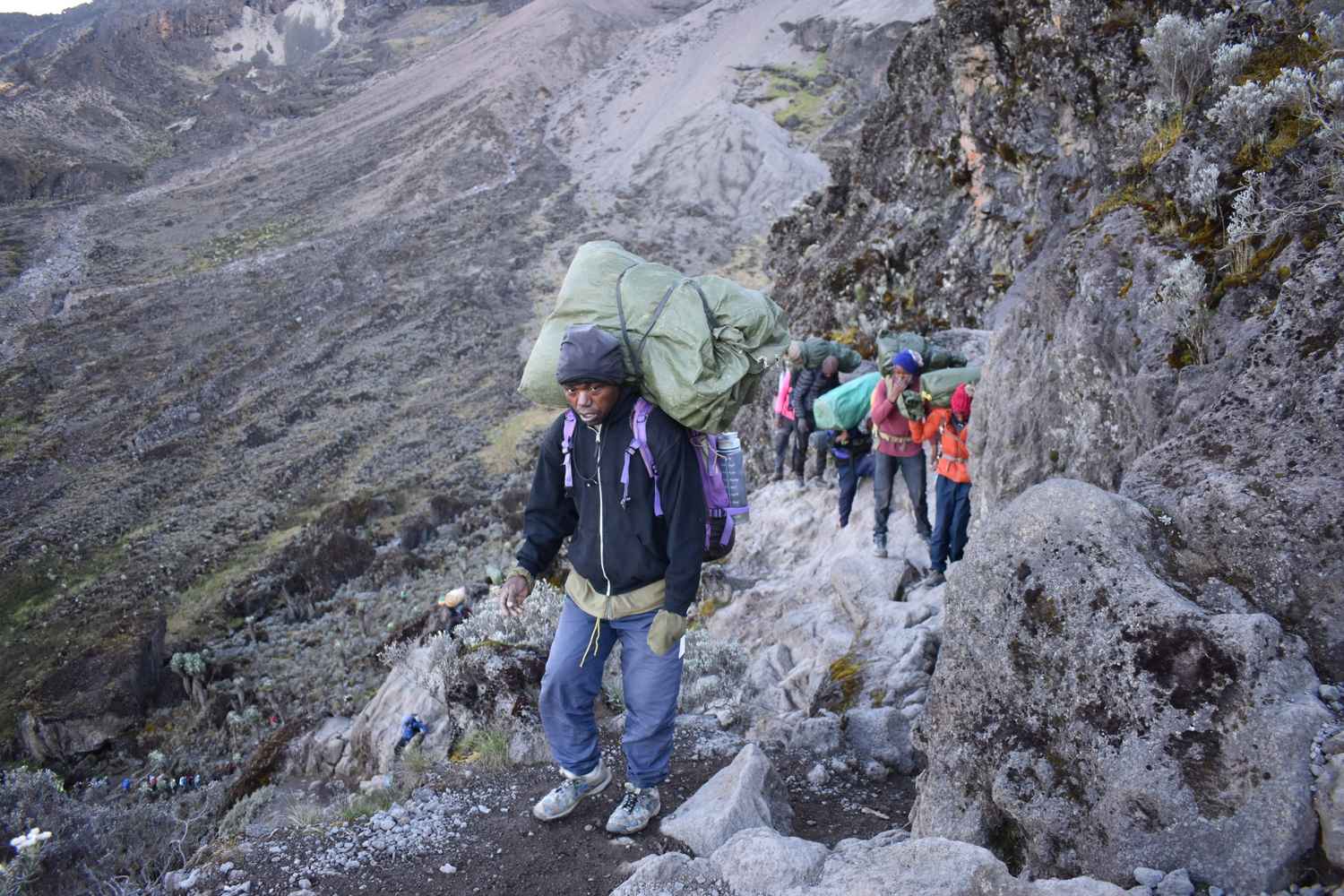
Porters and guides are very well acclimatised to the altitude as they are usually up the slopes several times a month. For the rest of us, the key is to go very slowly or 'pole pole'.
Acclimatization is the process by which the body becomes accustomed to lower availability of oxygen in the air and can only be achieved by spending time at various levels of altitude before progressing higher.
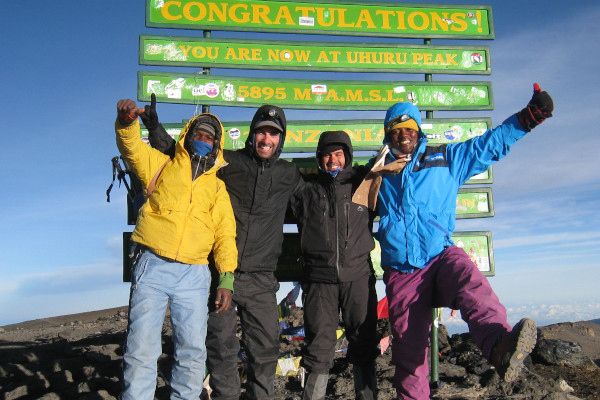
Plan your Kilimanjaro trek
Get a quote from my recommended local Kilimanjaro operator
Oxygen, Air Density and Altitude
Acclimatization is best understood by looking at the relationship between oxygen in the air, air density and altitude changes.
At sea level, oxygen accounts for about 21% of air and barometric pressure is around 760 mmHg (millilitres of mercury).
As one climbs in altitude the amount of oxygen in the air remains about the same (up to approximately 21,000 meters or 69,000 feet), however, air density drops and thus less pressure is put on packing oxygen molecules closer together (imagine oxygen molecules moving further and further away as altitude increases).
For example, at about 3,600 meters (12,000 feet), barometric pressure is around 480 mmHg.
With less air density, oxygen molecules are more widely dispersed in any given column of air and hence less oxygen is available per breath.
Blood oxygen saturation
The body deals with this decrease in available oxygen by breathing faster and deeper (even at rest) so as to increase the oxygen content in the blood (i.e. blood oxygen saturation or SO2).
The chart below shows the typical profile of oxygen saturation in an average person’s blood as one ascends to higher altitudes.
For the average person, you can see that blood oxygen saturation (SO2) decreases to nearly 80% at 6,000m (just above Kilimanjaro’s summit).
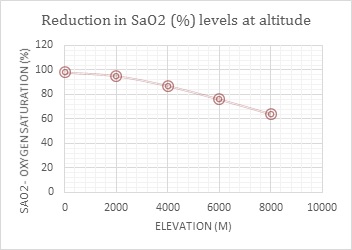
Kilimanjaro Altitude Zones
On Kilimanjaro there are three altitude zones
- High altitude (2,500 – 3,500 metres)
- Very high altitude (3,500 – 5,500 metres)
- Extreme altitude (above 5,500 metres).
Most people can ascend to 2,400 meters without experiencing the negative effects of altitude.
However, as one enters the high altitude zone changes in air density and available oxygen begin to impact one’s physiology.
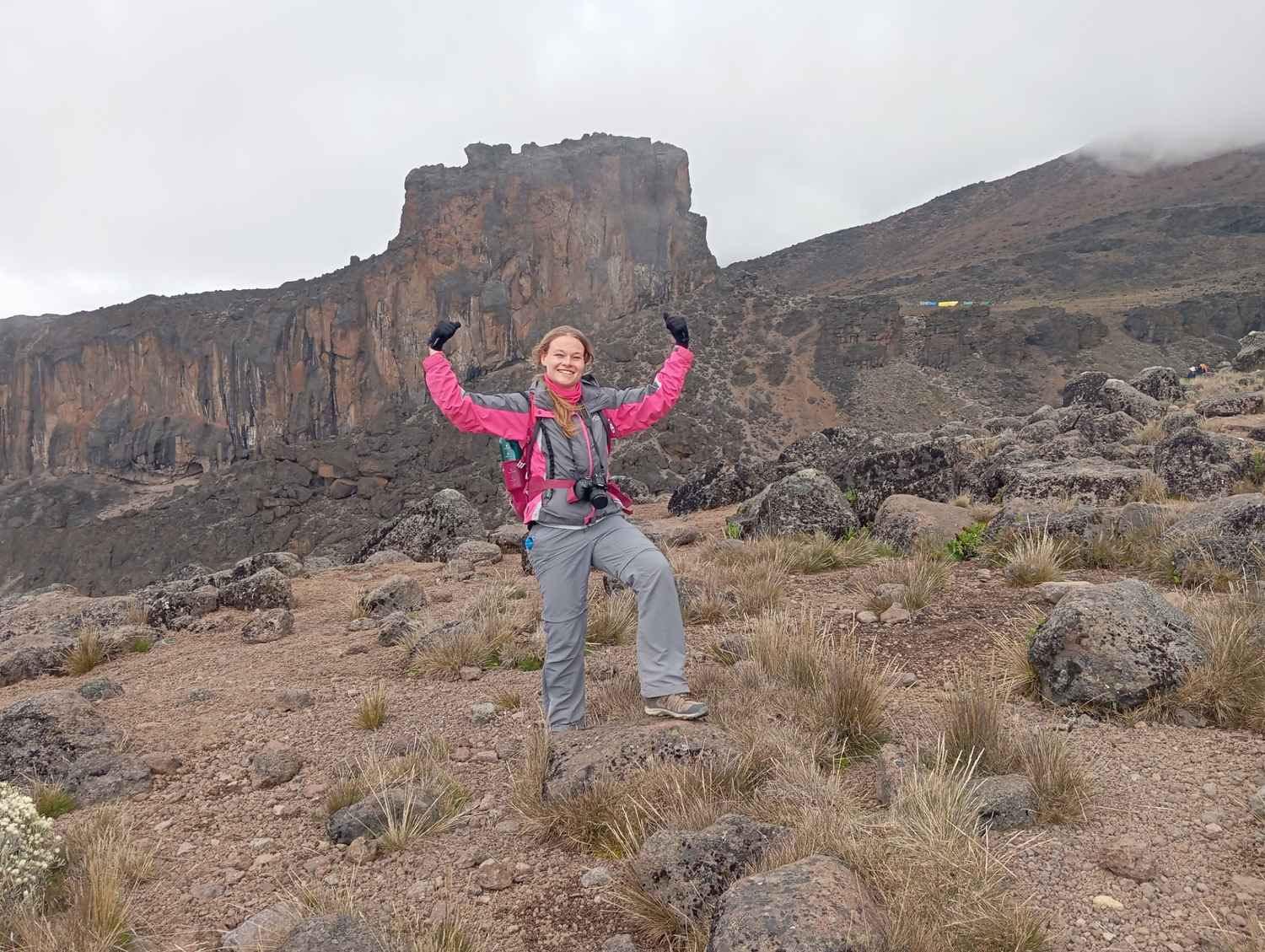
Lava Tower (4,600m) is where many trekkers on the Machame and Lemosho routes feel some form of altitude symptoms. This point is usually treated as a lunch stop and is a good test of how the body is coping. After lunch, you descend to camp.
One’s susceptibility to these changes is very difficult to predict, though, as there is very little correlation to factors of gender, age, fitness etc.
We do however know that going too high, too fast is the key cause of AMS. Other contributing factors are dehydration and over exertion at altitude.
A proper acclimatization strategy involves not going too high, too fast whilst also ensuring you don’t overexert yourself and remain well hydrated.
To illustrate this point it is worth thinking about a term that climbers call the acclimatization line.

Plan your Kilimanjaro trek
Get a quote from my recommended local Kilimanjaro operator
Acclimatization Line
The term is used to describe a point at which someone’s altitude sickness symptoms occur.
For example, let’s say a person’s acclimatization line is 3,000 metres on day one. After trekking to this height and spending a night or two there, the body would acclimatize to that altitude and that person’s line might move to 3,800 metres.
If they then climb to 3,700 metres they will remain asymptomatic, but if they climb to 4,000 metres they would begin to experience altitude sickness symptoms.
Very near to one’s acclimatization line the body can continue to adjust and a day or two’s rest at that height will usually result in the resolution of symptoms.
However if one continues to ascend beyond ones acclimatization line it is almost guaranteed that symptoms will worsen and further acclimatization will not occur.
It is critical that one gets below the point where symptoms began in order to see improvement.
This last point illustrates why it is so dangerous to ascend with any symptoms of altitude sickness.
How the body adapts to higher altitudes
Here’s the good news – your body is very good at adapting to changes in its environment.
Given enough time your body can adapt to high altitude. Four main body changes are worth mentioning. As you ascend:
- Breathing becomes a lot deeper and faster
- Red blood cell count increases which allows more oxygen to be carried in the blood
- Pressure in your pulmonary capillaries increases which forces blood into areas of the lungs that are not used when breathing at sea level
- More of a particular enzyme is produced which causes oxygen to be released from hemoglobin to the blood tissue
It is important to remember that your body can cope at altitude, it just needs time to acclimatize.

Altitude Sickness Kilimanjaro
Acute Mountain Sickness (AMS) – also know as altitude sickness and altitude illness – is a pathological effect on humans caused by going to high altitudes too fast, where lower levels in oxygen inhibit normal physiological processes.
People typically start experiencing Acute Mountain Sickness symptoms at about 10,000 feet (3,000 m).
Some people can experience symptoms as low as 8,000 feet (just over 2,400 m).
Due to Kilimanjaro’s rather rapid ascent profile altitude sickness amongst trekkers is unfortunately quite common.
There are three levels of Acute Mountain Sickness symptoms – mild, moderate and serious. I discuss each here.
- Moderate
- Severe
These include:
- Fatigue
- Headaches
- Nausea and Dizziness
- Shortness of breath
- Disturbed sleep
- Loss of appetite
If you suffer any of the symptoms above it is important to communicate to your climbing partners and guide how you are feeling.
These symptoms generally disappear if you rest for a day at the level at which they originally started. This is why an acclimatization day where you climb high and sleep low is so important!
High Altitude Pulmonary Edema (HAPE)
High Altitude Pulmonary Edema (HAPE) is a condition associated with Acute Mountain Sickness and occurs because of fluid build up in the lungs.
Fluid in the lungs prevents the effective exchange of oxygen and thus a decrease of oxygen into the bloodstream.
HAPE almost always occurs because of ascending too high, too fast.
It is a life threatening condition and therefore every precaution should be taken to avoid it when trekking Mount Kilimanjaro.
Clear symptoms that one is suffering from HAPE include:
- Very short of breath, even while resting
- Very tight chest
- The feeling of suffocation, particularly while sleeping
- Coughing that brings up white, frothy fluid
- Extreme fatigue and weakness
- Confusion, hallucination and irrational behaviour
If the last symptom occurs (i.e. confusion, hallucination and irrational behaviour) one can assume that the pulmonary edema has started to affect the brain due to a lack of oxygen in the bloodstream.
Any available oxygen should be administered. The drug, Nifedipine, has been shown to ameliorate the condition, but descent is the only cure.
Trekkers should take care to ensure that the person descending with High Altitude Pulmonary Edema doesn’t exert themselves as this can result in worsening of the condition.
A stretcher evacuation is the preferred method of descent.
Once the person has reached the lower limits of the mountain, medical support should be sought immediately.

Plan your Kilimanjaro trek
Get a quote from my recommended local Kilimanjaro operator
High Altitude Cerebral Edema (HACE)
High Altitude Cerebral Edema (HACE), is a condition associated with severe Acute Mountain Sickness. It occurs due to swelling of the brain tissue from fluid build up in the cranium. It is a life threatening condition.
On Kilimanjaro, people suffering from HACE should descend immediately and seek medial attention when they get to the lower reaches of the mountain.
HACE can be identified if someone is suffering from the following symptoms:
- Severe headaches which cannot be relieved by medication
- Hallucination
- Loss of consciousness
- Disorientation
- Loss of coordination (i.e. ataxia)
- Memory loss
- Coma
HACE tends to set in at night. Do not hang around until morning if someone in your group is suffering HACE symptoms.
The longer you wait at altitude the greater the probability of fatality. Descend immediately – even under darkness.
Under no circumstances should one ascend if they have suspected HACE symptoms. If you have oxygen it can be administered along with a steroid called, dexamethasone, but these should only be used in conjunction with rapid descent.
Lake Louise Altitude Sickness Scorecard
There are a number of ways to monitor altitude sickness symptoms. The most common method uses the Lake Louise Altitude Sickness Scorecard (as seen below).
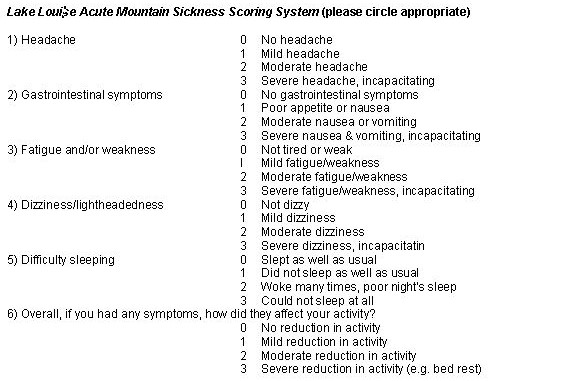
Scores between 3-7 are a sign of mild to moderate AMS. Scores above 7 are a sign of severe altitude sickness.
Reliable Kilimanjaro tour operators will use a combination of the Lake Louise scorecard method and spot oximeter and pulse readings to monitor your performance on the mountain.
If you score over 8 on the Lake Louise scorecard or have an SO2 reading below 75%, it is likely that you will need to forego your summit attempt and descend.

Plan your Kilimanjaro trek
Get a quote from my recommended local Kilimanjaro operator
Golden Rules- Kilimanjaro Altitude Sickness Tips
Trekking Kilimanjaro need not be a very risky or dangerous adventure as long as you follow some basic rules.
In particular:
- If you have a chance to pre-acclimatize before trekking Mount Kilimanjaro, do so. A good option in Tanzania is to trek the neighbouring Mount Meru (4,565 m) before attempting Kilimanjaro
- If you are a novice high altitude trekker then choose a Kilimanjaro route that is at least seven days long (6 up, 1 down). In our opinion, the seven day Machame or 7/8 day Lemosho are the most suitable routes for the average trekker
- Ensure the route allows for a good climb high, sleep low opportunity (both the Machame and Lemosho do)
- When on the mountain make a point to go as slowly as possible, do not overexert yourself, even on the lower reaches
- Drink loads of fluid (2.5-4 liters a day)
- Do not drink alcohol, take stimulants, smoke or consume caffeine on the mountain
- We recommend taking acetazolamide (Diamox)
Finally, as recommended by the charity, Altitude.org, always remember these 3 Golden Rules when at altitude:
- If you feel unwell, you have altitude sickness until proven otherwise
- Do not ascend further if you have symptoms of altitude sickness
- If you are getting worse then descend immediately
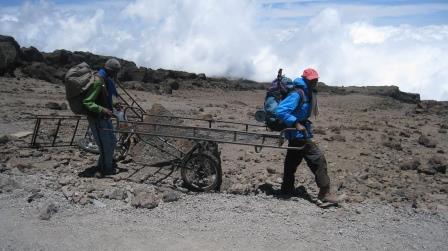
Preventative Medications – Diamox
Acetazolamide, or Diamox, is a drug that has been proved to be effective at mitigating altitude sickness.
The drug helps to increase the acidity of the blood by acting as a diuretic and promoting urination.
Increased acidity in the blood is equated by our bodies as increased CO2, and hence one starts breathing deeper and faster to get rid of the CO2.
Deeper, faster breathing increases the amount of oxygen received by the blood and this helps prevent the onset of AMS symptoms.
It is important to note that Diamox is a prophylactic (preventative medicine), and does not cure the symptoms of AMS. Once altitude sickness symptoms have started, the only way to stop them is descent.
My Pro Tip: Under no circumstances should Diamox be used to continue an ascent with AMS.
Diamox is also a prescription drug so it is important that you first consult your doctor to check whether it is a suitable drug given your particular medical history.
It is not suitable for pregnant women or anyone with kidney or liver disease issues.

Plan your Kilimanjaro trek
Get a quote from my recommended local Kilimanjaro operator
I recommend taking Diamox for 2-3 days 2 weeks before departure to test whether you experience any side effects.
Typical side effects associated with Diamox are:
- Frequent urination – everyone experiences this when taking Diamox. It can result in the development of kidney stones so it is important that you drink loads of fluids whilst taking the medication
- Numbness and tingling in the fingers, toes and face – Many people experience this side effect when taking Diamox. The sensation is a little discomforting but not dangerous
- Taste alterations (some foods might taste weird)
- Nausea, vomiting and diarrhea – this is rare. These side effects should be identified during your test before departing for Kilimanjaro. Unfortunately these side effects are common with AMS and therefore can easily be misdiagnosed as AMS
- Drowsiness and confusion is also possible – again these side effects can be confused with AMS
Diamox comes in 250mg tablets. Most people take half a tablet in the morning and half in the evening.
You should start taking tablets one day before arriving in Kilimanjaro and continue taking the same dosage for all ascent days. You can cease taking Diamox on descent.
My Final Thoughts
I hope this article has answered all your questions on acclimatization and altitude sickness on Kilimanjaro. If you have any more questions, feel free to leave a comment below, I will respond within 24 hours (so check back).
Read more climbing Kilimanjaro guides:

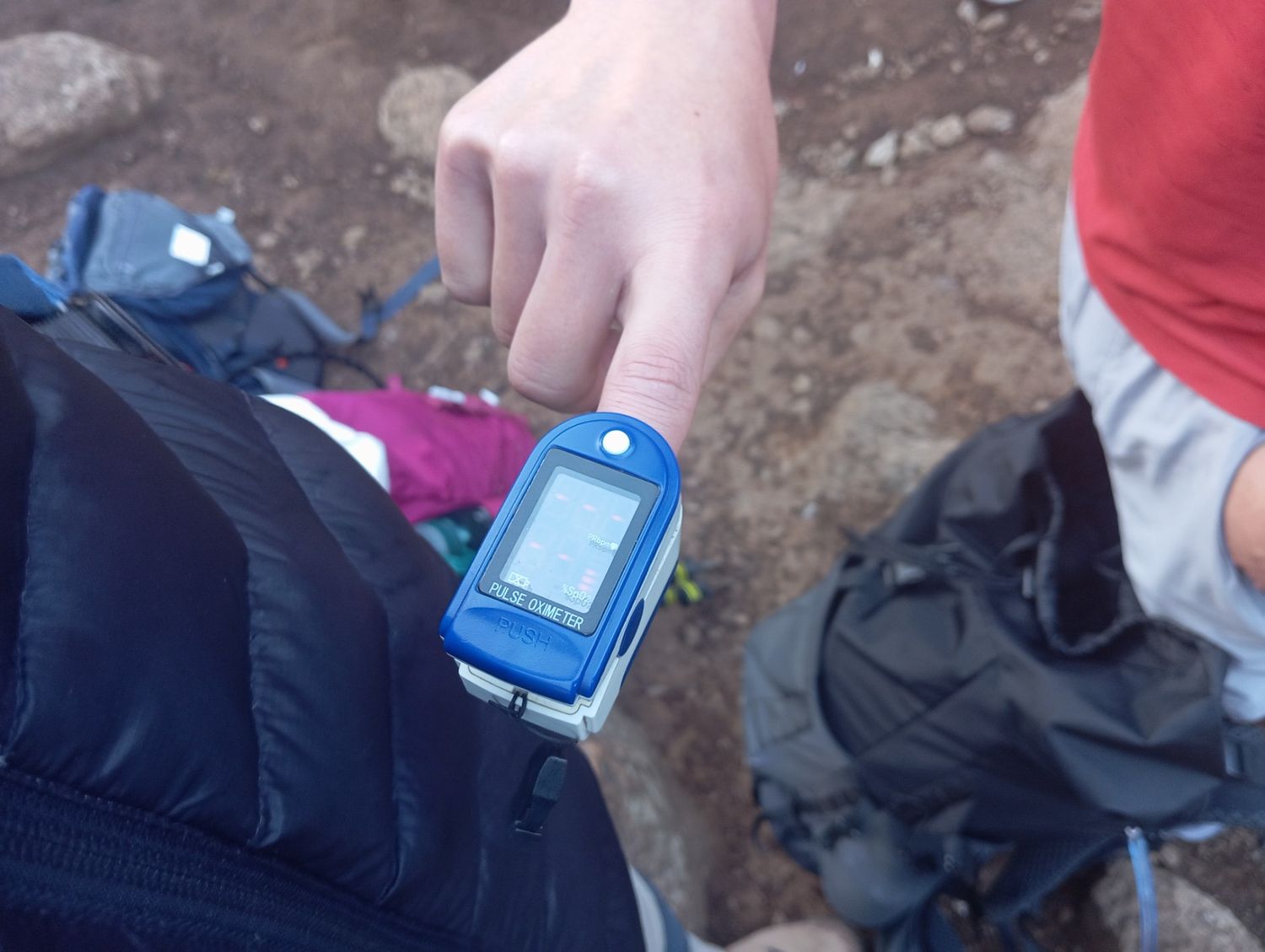
HI ,
I m a beginner and want to do Kilamanjaro in Oct 2025. You mentioned both Machame and Lemoso are suitable for average people. Which one is easier with higher successful rate?
Hi Tina, both routes has similar success rates. I recommend going for the 7 day Machame or 8 day Lemosho.
Hi Mark,
Excellent information and explained very well. I am planning to climb Mt. Kilimanjaro in July 2023. I would greatly appreciate any suggestions on how/what to pack.
Best Regards
Jay
Hi Jay, here’s a detailed packing list: https://www.climbkilimanjaroguide.com/kilimanjaro-kit-list/
Thank you for discussing acclimatization and how to go about it. I am going to be hiking Kilimanjaro with my husband this year. I will also find a source of altitude sickness oxygen to prepare for if it is needed.
Hi,
I’m considering Kili in Sept 2020, I hiked Toubkal 5 years ago and suffered mild AMS at about 13,000ft. the submit was literally a stones throw away but blimey in was a tough last few hundred feet.
We did ascend quickly.
I’m fairly fit, but 54 and very nervous.
Is there any clambering over rocks and is the terrain firm under foot on the way down?
Hi Trish, Kili is a big step up from Toubkal. If you take the Southern Circuit routes (Lemosho or Machame) then their is a section of scrambling called the Barranco Wall (read about it here: https://www.climbkilimanjaroguide.com/barranco-wall-mt-kilimanjaro/. The terrain higher up on the mountain is not very firm under foot – it consists of volcanic silt – and makes coming down quite tricky. The good news is that there are a few more days on Kili compared to Toubkal so acclimatisation is slightly better. I hope the above doesn’t put you off. I mention these points just to make sure you are mentally prepared – it’s a tougher challenge than Toubkal, but significantly more rewarding. All the best!
can I take sleep pills during at night the trekking, especially at higher altitude?
Hi David, I’m not sure. I would consult your doctor for advice.
Hi
2 years ago I suffered a heart attack followed by a cardiac arrest. I now have 3 stents and some slight permanent heart damage.
My cardiologist feels I am healthy and fit enough to climb Kiliminjaro physiologically, but says altitude sickness is an unknown quantity.
Do you know of anyone who has suffered heart trauma and still climbed?
Are their specialist companies who undertake the trek that have experience with medical conditions?
Climbing Kilimanjaro has been a lifetime dream, and I feel I was more at risk before my heart attack due to the unknown health factor, then I am now.
Regards
Greg Eather
Hi Greg, I suspect many people with heart conditions have climbed Kilimanjaro. Altitude sickness is indeed an unknown quantity, but if you follow the best practice guidance in this article then you will lower the risk of experiencing serious symptoms. Of course there is no guarantee that you will not experience altitude sickness. I’m not aware of specialist companies that can cater for medical conditions. There are some companies that will take a qualified doctor on a trek, but these tend to be large expedition groups. Unfortunately, I can’t provide any guidance on your medical condition but if your doctor has given you the green light then it’s worth starting a conversation with a tour operator to see if they would take you. All the best!
Nice Post.
Hi. I find it hard with warmth if the temps are really cold. Do you suggest a silk liner is best or what about a different material liner? for example Sea to Summit do an extreme liner? Thanks, Chantelle
Hi Chantelle, I recommend going for merino wool base layers. Check them out here: https://www.climbkilimanjaroguide.com/kilimanjaro-kit-list/kilimanjaro-clothing/
Hi,
My friend and I are planning to climb Kili in June this year. We don’t have a huge amount of time as we have kids at home so were planning to do the 5 day Marangu route but I am worried that we will have a much higher chance of altitude sickness as it’s shorter and therefore less time to acclimatize. What is your advice on this?
Thanks
Hi Rachel, unfortunately the shorter routes, like the 5-day Marangu come with higher risks of altitude sickness and lower summit success rates. If you can spare a day then I would go for the 6-day Machame. Ideally you want to look at a 7 or 8 day climb, like the Lemosho 8-day.
Hi,
I have climbed to Kilimanjaro-equivalent altitudes in the past (approx 15 years ago) and never experienced altitude sickness. Is it possible to become more susceptible to it as you age? Also, can reactions be different from climb to climb i.e. some climbs you will be fine and others you will encounter symptoms?
Thanks
Steve
Hi Steve, yes, the way one’s body responds to altitude can vary every time one goes to altitude. There are many experienced high altitude mountaineers who very seldom experience altitude sickness but then suddenly develop symptoms. Age, gender etc. doesn’t seem to have any correlation to prevalence of symptoms. My advice would be to follow the golden rules. 1. Choose a route that gives you loads of time to acclimatise and ideally a walk high , sleep low profile. 2. Go slowly, don’t rush. 3. Eat well and drink plenty of fluids. 4. Take Diamox.
Hey there… I know you touched on Dexamethasone as an alternative to Diamox but, if this is the main prophylaxis, you mentioned it comes with it’s own issues. What are they? Is it superior to diamox?
Hi Alan, I wouldn’t say Dexamethasone is an alternative to Diamox. It is a very powerful drug (a steroid) and should only be used on the advice of a physician. Generally it is used to treat swelling on the brain, which can in turn help with issues like HACE. I would consult your doctor in terms of its use, but in general it is not a drug that would be used on Kilimanjaro unless a doctor is around to administer it, and would only be used in an emergency evacuation.
Can you bring several bottles of “95%Pure aviators breathing oxygen”
I am 74 years old play 3x/weeks tennis for 2-3 hours/day and swim once a week. is practice hiking in Colorado recommended?
Would I qualify to climb the KILI ?
Hi Johannes, great to hear that you plan to climb Kilimanjaro. You sound like a very fit 74 year old, so I would say trekking Kilimanjaro is not the worst idea. It will be a very tough challenge, but many people in their 70s and some in their 80s have reached the summit. Practice hikes in Colorado are a great way to prepare. You want to get to a point where you can comfortable hike for 6-7 hours a day, for multiple days. As for taking oxygen, you will need to check with your tour operator. The best operators carry oxygen on their hikes, but only for emergency purposes. Hope this answers your questions, all the best!
I’ve done a day hike starting at 8,360 ft and summiting at 14,505 ft. Felt shortness of breath, a little spacey and mild headache past the 12000 ft mark up to the summit. If I were to take the 8 day Lemosho route do you think I’d be able to make it up ok without Diamox? I am feeling a little nervous about taking it since I’ve read so many mixed opinions on it.
Hi Alyssa, It is impossible to predict how you will respond to the altitude, but I will say you have chosen a great route for acclimatisation and Diamox is proven to help with acclimatization. Please note, it is not a cure for altitude sickness and should never be used to continue ascending if you are experiencing AMS symptoms. All the best!
I’ve hiked a mountain before. But i started at 800m and the summit was 1900m. I also have a house where i come 4 weeks a year for 15 years now. That house is standing at 900m high. I often go to 200m and 900m everyday. Do you think that will affect the chance of altitude sickness?
P.S
I also have a little fear of heights when it comes to not having anything to grab near me or narrow spaces, will that affect anything as well?
Hi Juri, Unfortunatley the altitudes you mention are too low to provide any indication of how your body will perform at high altitude. Most routes on Kilimanjaro start at around 1,800m and go to 2,500m on day 1. As long as you take a longer route like the 7 day Machame or 8 day lemosho you should give yourself the best chance to acclimatise. In terms of heights there are no real big exposures on Kilimanjaro – it really is just a hike. The Barranco wall is the one area where you need to do some scrambling – https://www.climbkilimanjaroguide.com/barranco-wall-mt-kilimanjaro/
I am on a diuretic already to deal with high blood pressure. should I continue taking it if I take Diamox as well
Hi Margaret, unfortunately we are not doctors. I would highly recommend you consult your doctor before taking Diamox. Cheers!
Hi Everyone,
I am a 25 years old male based in the UK and I have decided that I will climb Kilimanjaro in the next 2 years. As a hint at my previous hiking experience and current fitness level, I don’t have much hiking experience but have peaked Scafell Pike, Ben Nevis and Snowdonia 3 times each (inc. a three peaks challenge completed in under 24 hours) and I completed a marathon last month.
My first question is really about cost a.k.a. Price of EVERYTHING inc kit. How much will it all come to?
My second question is about my ability! Can I do it?
Thirdly and finally, hearing about Altitude sickness is pretty worrying! If you go with a tour agency, do they generally take more time to peak?
Looking forward to your advise!
Hi Lewis, the total cost for a Kilimanjaro climb (including flights, tips, gear etc) can range from $2500-$4000, depending on the route you choose and the quality of the operator. Local operators tend to be cheaper and run treks on shorter routes, so make sure you do your research when choosing an operator. In terms of ability you sound very fit so I’m sure you will reach the summit (assuming of course you don’t succumb to altitude sickness). The better tour operators usually only use the 7 and 8 day route variations which increase likelihood of proper acclimatisation. Hope this help!
hi team
i am looking at doing the climb around the 27 jan 2016. i am 44 yrs old and have lived by the sea all my life.
never hiked before
have had a bad slip disc 5 yrs ago.
will be doing the walking and pilatus starting oct to start the regimen.
have the will power
should i go for it ?
Hi Nagsri, this isn’t medical advice, but if you have the determination and grit to get to the top then I recommend going for it! Best of luck!
I would like to climb kilimanjaro by the lemosho route over 8 days, so camps at mti mkubwa, shira 1, shira 2, baranco, barafu (spending an additional day at barafu for acclimatisation and recovery and then uhuru and mweka and down.
A second alternative would be to spend a night at karanga after baranco and then barafu and the summit.
A third is to push straight through from baranco to barafu and save a day.
I am less keen on the third option but unsure about options 1 and 2.
Would you have advice and or suggestions?
Hi Sunil, the Lemosho route great route to the summit of Kilimanjaro. 8 Day variations have high summit success rates so you should be in a strong position to reach the Roof of Africa. As you suggested I would avoid option 3, the stretch from Barranco to Barafu is a big push, I have done it once before and wouldn’t recommend it. I would say option 2 is superior to option 1 as two days at Barafu is not ideal. Hope this helps!
Hi kili guide team,
Thank you for your quick response. It is indeed very helpful. Just a question, when you say that an overnight and rest at barafu isn’t ideal, is this because of the altitude or surroundings?
I was thinking that option 2 means an effective push of about 1800meters to the summit without sleep, whereas option 1 meant a push of 1200meters. I agree that this assumes one can sleep there.
I guess the other thing is that freezing temperatures at barafu for circa 36 hours are not great either and probably result in energy loss, right?
Hi Sunil, To be honest there is not much between the two options. My opinion is that option 2 is slightly better as the push from Karanga to Barafu is only a few hours, so you get to rest and relax at Barafu for most of the day and evening, before beginning your summit push around 12. Spending two nights at Barafu could be beneficial from an acclimatization perspective, but some people might not have acclimatised that well so spending an extra night at 4,600m before one has to can put one at extra risk of altitude sickness. Hope this makes sense, at the end of the day both option 1 and 2 aren’t bad, I just prefer the idea of a lower night at Karanga before pushing to Barafu.
Thank you very much for all your help.
I am starting to organize a hiking trip to the Kilimanjaro for the future, but I was wondering, how does living at a sea level city for many years (most of my live time actually) might have an effect on me while hiking the mountain?
Hi Dana, I would hazard a guess that most people who climb Kili have lived most, if not all, their lives at sea level. This fact shouldn’t put one at a disadvantage as every person needs to acclimatize to higher altitude, and can only do so by going higher in incremental stages (500m-70m a day) spread across as many days as possible. Hope this helps!
Hi, do we need to do acclimatization at kibo hut?
Some says it is best for us to do that but other think differently. Those who opposed argue that it is already too high to acclimatevat kibo hut and another day there leave us prone/exposed to altitude problem. They recommended to take very little time at Kibo and gear ahead to the summit saying that our body will not be able to get acclimatized while at the thermal which start at kibo,the body is getting acclimatized at Horombo hut and get energetic to pass through the saddle rest for few hours at kibo the up the summit and back to Horombo where there is good air.
Can you please advise.
Thanks,
Agnus
Hi Agnus, I would tend to agree that it is a bad idea to spend an acclimatisation day at Kibo Hut. I’m assuming you are trekking on the Marangu route. If so I would urge you to take the 6 day version and spend an acclimatisation day at Horombo hut. Hope this helps!
For how long is it allowed to stay at Uhuru Peak, before you have to start the decline, in order to avoid possible altitude sickness?
There is no maximum time you can spend at Uhuru Peak, but most people spend about 15-45 minutes enjoying the experience. Any longer and you would be putting yourself at increased risk of altitude sickness if you haven’t acclimatised properly.
Hi, I have Sickle Cell Trait, would this be a problem for me to go on the trek?
Hi Amma, I recommend consulting a qualified doctor before making any decisions. Unfortunately we don’t have the specialised expertise or knowledge on Sickle Cells or in fact any medical condition to make a judgement call. All the best!
Hi Amma
I also have SCT and I was wondering the same thing. Did you manage to speak with a qualified person? And if yes, what they recommended? Thank you
Hi
I wonder if you managed to get a medical advise on that
I have a very low resting heart rate, would that have any affect on me climbing Mt Kilimanjaro?
Hi Nony, I recommend contacting a medical professional for advice. All the best!
I am considering a visit to Mt. Kilimanjaro and was really wanting to do the whole climb to the top. However I do have COPD (Chronic Obstructive Pulmonary Disease) which also means I have chronic bronchitis and the beginnings of emphysema. With that known factor should I not attempt a climb to the top. However I probably would be safe and just go up to the first hut in a days climb. That I understand is on the Marangu route and would be Mandara Huts. And I think I have read that the elevation there is about 4700 feet. I also do have a portable oxygen machine that I need to use even here at home in Atlanta, GA USA. So I would be bringing that with me and have been told that there is electricity there at the Hut.
Hi Joseph, we highly recommend consulting your doctor before considering climbing Kilimanjaro. We are not physicians but our gut feel is that Kili may be too much of an ask given your condition. I realise this is probably not the answer you are looking for, but ultimately your safety is more important than reaching the summit and going up to even a moderate height will put dangerous strain on your heart and lungs. Hope this helps and please seek proper medical advice before making a decision. Best regards!